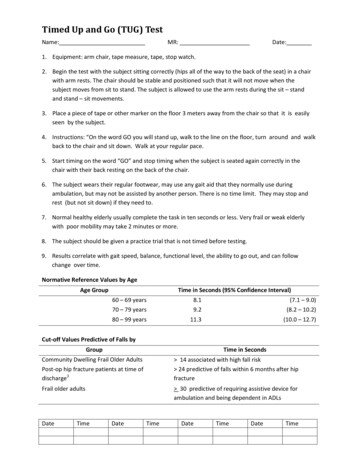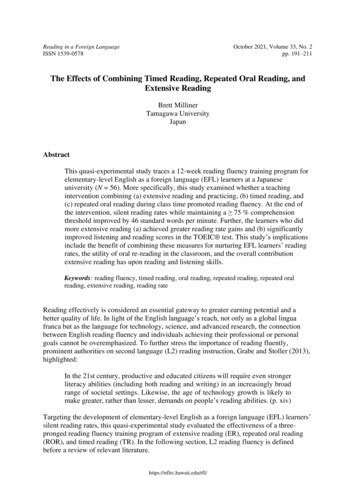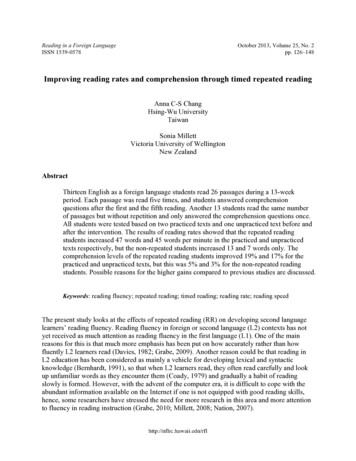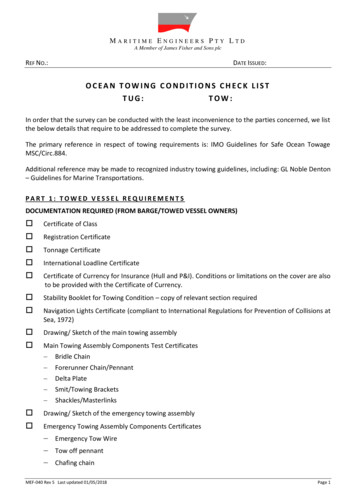
Transcription
Timed Up and Go (TUG) TestName:MR:Date:1. Equipment: arm chair, tape measure, tape, stop watch.2. Begin the test with the subject sitting correctly (hips all of the way to the back of the seat) in a chairwith arm rests. The chair should be stable and positioned such that it will not move when thesubject moves from sit to stand. The subject is allowed to use the arm rests during the sit – standand stand – sit movements.3. Place a piece of tape or other marker on the floor 3 meters away from the chair so that it is easilyseen by the subject.4. Instructions: “On the word GO you will stand up, walk to the line on the floor, turn around and walkback to the chair and sit down. Walk at your regular pace.5. Start timing on the word “GO” and stop timing when the subject is seated again correctly in thechair with their back resting on the back of the chair.6. The subject wears their regular footwear, may use any gait aid that they normally use duringambulation, but may not be assisted by another person. There is no time limit. They may stop andrest (but not sit down) if they need to.7. Normal healthy elderly usually complete the task in ten seconds or less. Very frail or weak elderlywith poor mobility may take 2 minutes or more.8. The subject should be given a practice trial that is not timed before testing.9. Results correlate with gait speed, balance, functional level, the ability to go out, and can followchange over time.Normative Reference Values by Age1Age GroupTime in Seconds (95% Confidence Interval)60 – 69 years8.1(7.1 – 9.0)70 – 79 years9.2(8.2 – 10.2)80 – 99 years11.3(10.0 – 12.7)Cut-off Values Predictive of Falls byGroupTime in SecondsCommunity Dwelling Frail Older Adults2Post-op hip fracture patients at time ofdischarge3 14 associated with high fall risk 24 predictive of falls within 6 months after hipfractureFrail older adults 30 predictive of requiring assistive device forambulation and being dependent in ADLsDateTimeDateTimeDateTimeDateTime
References1. Bohannon RW. Reference values for the Timed Up and Go Test: A Descriptive Meta-Analysis. Journalof Geriatric Physical Therapy, 2006;29(2):64-8.2. Shumway-Cook A, Brauer S, Woollacott M. Predicting the probability for falls in community-dwellingolder adults using the timed up & go test. Phys Ther. 2000;80:896-903.3. Kristensen MT, Foss NB, Kehlet H. Timed "Up and Go" Test as a predictor of falls within 6 monthsafter hip fracture surgery. Phys Ther. 2007.87(1):24-30.Additional ReferencesBischoff HA, Stahelin HB, et al. Identifying a cut-off point for normal mobility: A comparison study of thetimed "up and go" test in community-dwelling and institutionalized elderly women. Age andAgeing. 2003;32:315-320.Boulgarides LK, McGinty SM, et al. Use of clinical and impairment-based tests to predict falls bycommunity-dwelling older adults. Phys Ther. 2003;83:328-339.Podsiadlo D, Richardson S. The timed “up & go": A test of basic functional mobility for frail elderlypersons. JAGS. 1991;39:142-148.
Patient:Date:Time:AM/PMThe 4-Stage Balance TestPurpose: To assess static balanceEquipment: A stopwatchDirections: There are four progressively more challengingpositions. Patients should not use an assistive device (cane orwalker) and keep their eyes open.Describe and demonstrate each position. Stand next to the patient,hold his/her arm and help them assume the correct foot position.When the patient is steady, let go, but remain ready to catch thepatient if he/she should lose their balance.If the patient can hold a position for 10 seconds without movinghis/her feet or needing support, go on to the next position.If not, stop the test.Instructions to the patient: I’m going to show you four positions.Try to stand in each position for 10 seconds. You can hold yourarms out or move your body to help keep your balance butdon’t move your feet. Hold this position until I tell you to stop.For each stage, say “Ready, begin” and begin timing.After 10 seconds, say “Stop.”See next page for detailed patient instructions andillustrations of the four positions.For relevant articles, go to: www.cdc.gov/injury/STEADICenters for DiseaseControl and PreventionNational Center for InjuryPrevention and Control
Instructions to the patient:1. Stand with your feet side by side.Time: seconds2. Place the instep of one foot so it istouching the big toe of the other foot.Time: seconds3. Place one foot in front of the other,heel touching toe.Time: seconds4. Stand on one foot.Time: secondsAn older adult who cannot hold the tandem stance for at least 10 secondsis at increased risk of falling.Notes:
Functional Reach TestThe Functional Reach Test was first developed by Pamela Duncan and colleagues in1990. It is a quick and simple, single-task dynamic test that defines functional reach as"the maximal distance one can reach forward beyond arm's length, while maintaining afixed base of support in the standing position" (Duncan et al., 1990).It is a dynamic rather than a static test and measures a person's"margin of stability" as well as ability to maintain balance during a functional task. Thetest has been shown by Duncan to be predictive of falls in older adults (Duncan et al.,1990).Functional reach is tested by placing a yardstick or tape measure on the wall, parallel tothe floor, at the height of the acromion of the subject's dominant arm. The subject isasked to stand with the feet a comfortable distance apart, make a fist, and forward flexthe dominant arm to approximately 90 degrees. The subject is asked to reach forward asfar as possible without taking a step or touching the wall. The distance between the startand end point is then measured using the head of the metacarpal of the third finger as thereference point (Duncan et al., 1990).FUNCTIONAL REACH NORMSAgeMenWomen20-4016.73 inches14.64 inches41-6914.98 inches13.81 inches70-8713.16 inches10.47 inchesSource: Duncan et al., 1990.
Appendix.Functional Gait AssessmentaRequirements: A marked 6-m (20-ft) walkway that is marked with a 30.48-cm (12-in) width.1. GAIT LEVEL SURFACEInstructions: Walk at your normal speed from here to the next mark (6 m[20 ft]).Grading: Mark the highest category that applies.(3) Normal—Walks 6 m (20 ft) in less than 5.5 seconds, no assistivedevices, good speed, no evidence for imbalance, normal gaitpattern, deviates no more than 15.24 cm (6 in) outside of the30.48-cm (12-in) walkway width.(2) Mild impairment—Walks 6 m (20 ft) in less than 7 seconds butgreater than 5.5 seconds, uses assistive device, slower speed,mild gait deviations, or deviates 15.24 –25.4 cm (6 –10 in)outside of the 30.48-cm (12-in) walkway width.(1) Moderate impairment—Walks 6 m (20 ft), slow speed, abnormal gait pattern, evidence for imbalance, or deviates 25.4 –38.1 cm (10 –15 in) outside of the 30.48-cm (12-in) walkwaywidth. Requires more than 7 seconds to ambulate 6 m (20 ft).(0) Severe impairment—Cannot walk 6 m (20 ft) without assistance,severe gait deviations or imbalance, deviates greater than 38.1cm (15 in) outside of the 30.48-cm (12-in) walkway width orreaches and touches the wall.2. CHANGE IN GAIT SPEEDInstructions: Begin walking at your normal pace (for 1.5 m [5 ft]). WhenI tell you “go,” walk as fast as you can (for 1.5 m [5 ft]). When I tell you“slow,” walk as slowly as you can (for 1.5 m [5 ft]).Grading: Mark the highest category that applies.(3) Normal—Able to smoothly change walking speed without loss ofbalance or gait deviation. Shows a significant difference inwalking speeds between normal, fast, and slow speeds. Deviates no more than 15.24 cm (6 in) outside of the 30.48-cm(12-in) walkway width.(2) Mild impairment—Is able to change speed but demonstratesmild gait deviations, deviates 15.24 –25.4 cm (6 –10 in) outsideof the 30.48-cm (12-in) walkway width, or no gait deviations butunable to achieve a significant change in velocity, or uses anassistive device.(1) Moderate impairment—Makes only minor adjustments to walking speed, or accomplishes a change in speed with significantgait deviations, deviates 25.4 –38.1 cm (10 –15 in) outside the30.48-cm (12-in) walkway width, or changes speed but losesbalance but is able to recover and continue walking.(0) Severe impairment—Cannot change speeds, deviates greaterthan 38.1 cm (15 in) outside 30.48-cm (12-in) walkway width,or loses balance and has to reach for wall or be caught.3. GAIT WITH HORIZONTAL HEAD TURNSInstructions: Walk from here to the next mark 6 m (20 ft) away. Beginwalking at your normal pace. Keep walking straight; after 3 steps, turnyour head to the right and keep walking straight while looking to theright. After 3 more steps, turn your head to the left and keep walkingstraight while looking left. Continue alternating looking right and leftevery 3 steps until you have completed 2 repetitions in each direction.Grading: Mark the highest category that applies.(3) Normal—Performs head turns smoothly with no change in gait.Deviates no more than 15.24 cm (6 in) outside 30.48-cm (12-in)walkway width.(2) Mild impairment—Performs head turns smoothly with slightchange in gait velocity (eg, minor disruption to smooth gaitpath), deviates 15.24 –25.4 cm (6 –10 in) outside 30.48-cm(12-in) walkway width, or uses an assistive device.(1) Moderate impairment—Performs head turns with moderatechange in gait velocity, slows down, deviates 25.4 –38.1 cm(10 –15 in) outside 30.48-cm (12-in) walkway width but recovers, can continue to walk.(0) Severe impairment—Performs task with severe disruption of gait(eg, staggers 38.1 cm [15 in] outside 30.48-cm (12-in) walkwaywidth, loses balance, stops, or reaches for wall).4. GAIT WITH VERTICAL HEAD TURNSInstructions: Walk from here to the next mark (6 m [20 ft]). Begin walkingat your normal pace. Keep walking straight; after 3 steps, tip your headup and keep walking straight while looking up. After 3 more steps, tipyour head down, keep walking straight while looking down. Continuealternating looking up and down every 3 steps until you have completed2 repetitions in each direction.Grading: Mark the highest category that applies.(3) Normal—Performs head turns with no change in gait. Deviatesno more than 15.24 cm (6 in) outside 30.48-cm (12-in) walkwaywidth.(2) Mild impairment—Performs task with slight change in gaitvelocity (eg, minor disruption to smooth gait path), deviates15.24 –25.4 cm (6 –10 in) outside 30.48-cm (12-in) walkwaywidth or uses assistive device.(1) Moderate impairment—Performs task with moderate change ingait velocity, slows down, deviates 25.4 –38.1 cm (10 –15 in)outside 30.48-cm (12-in) walkway width but recovers, cancontinue to walk.(0) Severe impairment—Performs task with severe disruption of gait(eg, staggers 38.1 cm [15 in] outside 30.48-cm (12-in) walkwaywidth, loses balance, stops, reaches for wall).5. GAIT AND PIVOT TURNInstructions: Begin with walking at your normal pace. When I tell you,“turn and stop,” turn as quickly as you can to face the opposite directionand stop.Grading: Mark the highest category that applies.(3) Normal—Pivot turns safely within 3 seconds and stops quicklywith no loss of balance.(2) Mild impairment—Pivot turns safely in 3 seconds and stopswith no loss of balance, or pivot turns safely within 3 secondsand stops with mild imbalance, requires small steps to catchbalance.(1) Moderate impairment—Turns slowly, requires verbal cueing, orrequires several small steps to catch balance following turn andstop.(0) Severe impairment—Cannot turn safely, requires assistance toturn and stop.6. STEP OVER OBSTACLEInstructions: Begin walking at your normal speed. When you come to theshoe box, step over it, not around it, and keep walking.Grading: Mark the highest category that applies.(3) Normal—Is able to step over 2 stacked shoe boxes tapedtogether (22.86 cm [9 in] total height) without changing gaitspeed; no evidence of imbalance.(2) Mild impairment—Is able to step over one shoe box (11.43 cm[4.5 in] total height) without changing gait speed; no evidenceof imbalance.(1) Moderate impairment—Is able to step over one shoe box (11.43cm [4.5 in] total height) but must slow down and adjust steps toclear box safely. May require verbal cueing.(0) Severe impairment—Cannot perform without assistance.(Continued)
Appendix.Continued7. GAIT WITH NARROW BASE OF SUPPORTInstructions: Walk on the floor with arms folded across the chest, feetaligned heel to toe in tandem for a distance of 3.6 m [12 ft]. The numberof steps taken in a straight line are counted for a maximum of 10 steps.Grading: Mark the highest category that applies.(3) Normal—Is able to ambulate for 10 steps heel to toe with nostaggering.(2) Mild impairment—Ambulates 7–9 steps.(1) Moderate impairment—Ambulates 4 –7 steps.(0) Severe impairment—Ambulates less than 4 steps heel to toe orcannot perform without assistance.8. GAIT WITH EYES CLOSEDInstructions: Walk at your normal speed from here to the next mark (6 m[20 ft]) with your eyes closed.Grading: Mark the highest category that applies.(3) Normal—Walks 6 m (20 ft), no assistive devices, good speed,no evidence of imbalance, normal gait pattern, deviates no morethan 15.24 cm (6 in) outside 30.48-cm (12-in) walkway width.Ambulates 6 m (20 ft) in less than 7 seconds.(2) Mild impairment—Walks 6 m (20 ft), uses assistive device,slower speed, mild gait deviations, deviates 15.24 –25.4 cm(6 –10 in) outside 30.48-cm (12-in) walkway width. Ambulates6 m (20 ft) in less than 9 seconds but greater than 7 seconds.(1) Moderate impairment—Walks 6 m (20 ft), slow speed, abnormal gait pattern, evidence for imbalance, deviates 25.4 –38.1cm (10 –15 in) outside 30.48-cm (12-in) walkway width.Requires more than 9 seconds to ambulate 6 m (20 ft).(0) Severe impairment—Cannot walk 6 m (20 ft) without assistance,severe gait deviations or imbalance, deviates greater than 38.1cm (15 in) outside 30.48-cm (12-in) walkway width or will notattempt task.a9. AMBULATING BACKWARDSInstructions: Walk backwards until I tell you to stop.Grading: Mark the highest category that applies.(3) Normal—Walks 6 m (20 ft), no assistive devices, good speed,no evidence for imbalance, normal gait pattern, deviates nomore than 15.24 cm (6 in) outside 30.48-cm (12-in) walkwaywidth.(2) Mild impairment—Walks 6 m (20 ft), uses assistive device,slower speed, mild gait deviations, deviates 15.24 –25.4 cm(6 –10 in) outside 30.48-cm (12-in) walkway width.(1) Moderate impairment—Walks 6 m (20 ft), slow speed, abnormal gait pattern, evidence for imbalance, deviates 25.4 –38.1cm (10 –15 in) outside 30.48-cm (12-in) walkway width.(0) Severe impairment—Cannot walk 6 m (20 ft) without assistance,severe gait deviations or imbalance, deviates greater than 38.1cm (15 in) outside 30.48-cm (12-in) walkway width or will notattempt task.10. STEPSInstructions: Walk up these stairs as you would at home (ie, using the railif necessary). At the top turn around and walk down.Grading: Mark the highest category that applies.(3) Normal—Alternating feet, no rail.(2) Mild impairment—Alternating feet, must use rail.(1) Moderate impairment—Two feet to a stair; must use rail.(0) Severe impairment—Cannot do safely.TOTAL SCORE:MAXIMUM SCORE 30Adapted from Dynamic Gait Index.Reference: Wrisley DM, Marchetti GF, Kuharsky DK, Whitney SL. Reliability, internal consistency, and validity ofdata obtained with the functional gait assessment. Phys Ther. 2004;84(10):906-918.Adapted from Dynamic Gait Index with permission from Anne Shumway-Cook, PT, PhD, FAPTA, copyright 1995.
Normative Values:Healthy Adults:(Walker et al, 2007; n 200, aged 40 to 89. UnimpairedAdults)Agen Min score Max score Mean SD95% CI40-49 27243028.9 1.5 28.3-29.550-59 33253028.4 1.6 27.9-29.060-69 63203027.1 2.3 26.5-27.770-79 44163024.9 3.6 23.9-26.080-89 33102820.8 4.7 19.2-22.6Total 200103026.1 4.0 25.5-26.6 Mean total FGA scores demonstrate an overall decreasewith increased age Increased variability in scores noted with each decadeincrease in age (increased SD’s)Information taken from Rehab Measures
Morse Fall ScaleFall Risk is based upon Fall Risk Factors and it is more than a Total Score. Determine Fall RiskFactors and Target Interventions to Reduce Risks. Complete on admission, at change of condition,transfer to a new unit, and after a fall.VariablesScoreHistory oryAidNone/bedrest/nurse assist0Crutches/cane/walker15Furniture30IV or 10Impaired20Knows own limits0Overestimates or forgets limits15MentalStatusAdmissionDateTotalSignature & StatusTo obtain the Morse Fall Score add the score from each category.Morse Fall ScoreHigh Risk45 and higherModerate Risk25-44Low Risk0-24Note: Complete checklist for resident assessed based on level of risk.ReviewDateReviewDate
de Morton Mobility Index (DEMMI)012Bed1. Bridge2. Roll onto side3. Lying to sitting unable unable unable able able min assist supervisionChair4. Sit unsupported in chair5. Sit to stand from chair unable unable unable 10 sec min assist supervision able unable unable unable unable 10 sec 10 sec 10 sec 10 sec unable 5m unable min assist supervision 10m 20m independent unable unable unable able able able6. Sit to stand without using armsStatic balance (no gait aid)7. Stand unsupported8. Stand feet together9. Stand on toes10. Tandem stand with eyes closedWalking11. Walking distance /- gait aidGait aid (circle): nil/frame/stick/other12. Walking independenceDynamic balance (no gait aid)13. Pick up pen from floor14. Walks 4 steps backwards15. Jumpeasiestsit unsupported independentbridgestand unsupported independentsit to standrolllie to sitstanding feet together 50mpick up pen from floor independentwith gait aidwalks backwardswithout gait aidwalking distancesit to stand no armswalking independenceCOLUMN TOTAL SCORE:jumpRAW SCORE TOTAL(sum of column total scores)stand on toes/19DEMMI SCORE(MDC90 9 points; MCID 10 points)tandem stand eyes closed/100hardestRaw-DEMMI Score Conversion TableRaw Score012345678910111213141516171819DEMMI ts:Signature:Date:
2.3.1.Person is asked to maintain sitting balance for 10 seconds while seated on the chair,without holding arm rests, slumping or swaying. Knees and feet are placed together andfeet can be resting on the floor.Person is asked to rise from sitting to standing using the arm rests of the chair.Person is asked to stand with their arms crossed over their chest.Person is lying supine and is asked to bend their knees and lift their bottom clear of thebed.Person is lying supine and is asked to roll onto one side without external assistance.Person is lying supine and is asked to sit up over the edge of the esting should be performed at the person’s bedside.Testing should be performed when the person has adequate medication eg. at least halfan hour after pain or Parkinson’s Disease medication.The test should be administered in the sequence described in sections A-E: bedtransfers, chair transfers, static balance, walking and dynamic balance.Each item should be explained and, if necessary, demonstrated to the person.Items should be ticked to indicate item success or failure. Reasons for not testing itemsshould be recorded.Items should not be tested if either the test administrator or the person performing thetest are reluctant to attempt the item.Persons should be scored based on their first attempt.If an item is not appropriate given a person’s medical condition, the item should not betested and the reason recorded.Persons can be encouraged but feedback should not be provided regardingperformance.Three equipment items are required: chair with 45cm seat height with arm rests, ahospital bed or plinth and a pen.The person administering the test manipulates person medical equipment during testing(eg. portable oxygen, drips, drains etc) unless the person requires minimal assistance toperform the test and then a 2nd person will be required to assist with medical equipment.For persons that require a rest after each item due to shortness of breath, a 10 minuterest should be provided half way through testing i.e. after completing the chair transferssection.For person’s who have low level mobility and require a hoist to transfer in/out of bed orchair, the chair section can be administered before the bed section for these persons.Bed transfers: the bed height should be appropriate for the individual person. Astandardised hospital bed or plinth should be used for testing. The person cannot use anexternal device such as the monkey bar, bed rail, edge of bed or a bed pole. Additionalpillows may be provided for persons who are unable to lie flat in supine.Chair transfers: A standardised chair height of 45cm is required. A firm chair with armsshould be used.Balance: Shoes cannot be worn for balance testing. The person cannot use externalsupport to successfully complete any balance items. For sitting balance, neither the armrests or the back of the chair can be used for external support. Standing balance testsshould be performed with the person positioned between an elevated bed on one sideand the test administrator on the other side. If a person displays unsteadiness orsignificant sway during testing, testing of that item should cease.Walking: Appropriate shoes can be worn for walking tests. The same shoes must beworn for repeat testing.Scoring: Using the conversion table provided, the raw score total must be converted to aDEMMI SCORE.PROTOCOL FOR ADMINISTRATION OF THE DEMMIThe DEMMI should be cited as: de Morton NA, Davidson M, Keating JL. The de Morton Mobility Index (DEMMI): an essential health index for an ageing world. Health and Quality of Life Outcomes2008, 6:63.The development of the DEMMI has been supported by a post graduate scholarship from the National Health and Medical Research Council of Australia (Dora Lush Postgraduate Scholarship, Grant no.280632), funded by the HCF Health and Medical Research Foundation and also supported by The Northern Clinical Research Centre, Northern Health. Copyright de Morton, Davidson & Keating 2007. The DEMMI may be printed or reproduced without alteration (retaining this copyright notice). All other rights reserved. For other authorisations (including totranslate the DEMMI) contact Dr Natalie de Morton: al assistance “hands on” physical but minimal assistance, primarily to guide movement.Supervision another person monitors the activity without providing hands on assistance. Mayinclude verbal prompting.Independent the presence of another person is not considered necessary for safe mobility.Dynamic Balance13. A pen is placed 5 cm in front of the person’s feet in standing. The person is asked if theycan pick the pen up off the floor.14. Walks backwards 4 steps. Person remains steady throughout.15. Person can jump. Both feet clear the ground. Person remains steady throughout.Walking11. Persons will be asked to walk with their current gait aid to where they can without a rest.Testing ceases if the person stops to rest. The person uses the gait aid that is currentlymost appropriate for them. If either of two gait aids could be used, the aid that providesthe person with the highest level of independence should be used. Testing ceases oncethe person reaches 50 meters.12. Independence is assessed over the person’s maximum walking distance up to 50m (fromitem 11).Static Balance7. The person is asked if they can stand for 10 seconds without external support.8. The person is asked if, for 10 seconds, they can stand with their feet together.9. The person is asked if they can stand on their toes for 10 seconds.10. The person is asked to place the heel of one foot directly in front of the other with theireyes closed for 10 seconds.5.6.Chair4.BedITEM INSTRUCTIONS
Floor to Stand Transfer1. Have the patient start seated in a chair2. Move to the floor and down to aseated position if able3. Move back up to kneeling, then to 1knee then stand upWhat muscles are activated and in whatway?Modifications may be done as neededEven chair sit to half kneel will activatemuscles in ways we don’t always exerciseour residents
Algorithm for Fall Risk Assessment & InterventionsPatient completes Stay Independent brochureScreen for falls and/or fall riskPatient answers YES to any key question:NO toall keyquestionsEvaluate gait, strength & balance Timed Up & Go (recommended) 30 Second Chair Stand (optional) 4 Stage Balance Test (optional)No gait,strengthor balanceproblems*Gait, strength or balance problem 2 falls1 fallInjuryNo injuryHIGH RISKIndividualized fallinterventions Educate patient Vitamin D /- calcium Refer to PT to enhancefunctional mobility & improvestrength & balance Manage & monitorhypotension Modify medications Address foot problems Optimize vision Optimize home safetyFollow up with HIGH RISKpatient within 30 days Review care plan Assess & encourage fall riskreduction behaviors Discuss & address barriersto adherence————Transition to maintenanceexercise program whenpatient is ready*For these patients, consider additional risk assessment (e.g., medication review, cognitive screen, syncope)Centers for DiseaseControl and PreventionNational Center for InjuryPrevention and ControlHigh RiskConduct multifactorialrisk assessment Review Stay Independentbrochure Falls history Physical exam including:- Postural dizziness/postural hypotension- Medication review- Cognitive screen- Feet & footwear- Use of mobility aids- Visual acuity check0 fallsMODERATE RISKIndividualized fallinterventions E ducate patient R eview & modify medications V itamin D /- calcium R efer to PT to improve gait,strength & balanceor refer to a community fallprevention programModerate RiskYES to any key questionLOW RISKIndividualized fallinterventions Educate patient Vitamin D /- calcium Refer for strength & balanceexercise (community exerciseor fall prevention program)Low Risk Fell in past year? If YES ask,-H ow many times? and,- Were you injured? Feels unsteady when standing or walking? Worries about falling?
Therapy Discharge Recommendations – SampleDate:Name:You are being discharged to:Precautions:Home exercise programs: (if given in writing note this on linebelow)PT:OT:Speech/swallowing:Training completed during your stay:Recommendations for next level of care:We want to remind you that someone from the rehab programwill be calling you at 30/60 and 90 days after your discharge tosee how you are doing.Signatures:
IDT Discharge Care Transitions Checklisto Order for discharge given by MDo Patient and family aware of d/c date andrecommendations for care transitiono DME obtainedo Follow up appointments madeo Patient notified in writingo Transportation establishedo Referral made for next level of careo Labs and any other tests (such as PTINR) sent tocommunity MDo Also to HHA if appropriateo PT/OT/ SLP discharge summaries completedo Therapy provided & reviewed written dischargerecommendations with patient/family, including but notlimited to home exercise programso Medication review performed with patient/familyo Patient/family training has been completed andcompetence demonstratedo Review of discharge paperwork was completed withpatient/family by discharging nurse
Tracking sheet for post-dc calls30-day post d/c60 -day post d/c90-day post d/cDateDateDateCommentsHave you seenyour doctor sinced/c?Have you fallen orhad any injuries?Have you been tothe ED/ER?Have you been inthe hospital?Are you gettingany therapy?If Yes, note typeand locationAre you havingany problems?Any questions?Recommend inserting grid in EMR but if not an option, can put on paper with name/DOB and d/c dateon top
Documentation Audit SamplesPlease check your payers, state laws and accreditationorganizations for compliance specifics;Add date of audit, patient identifiers if neededCould also add outcome or plan if doing multiple records andwant to use for QAPI or staff educationEvaluation metrics1. History including PLOF and home environment2. Diagnosis, co-morbidities, social support, cognitive level ,ICD-10 and functional limitations3. Examination of systems4. Tests performed (at least 1) with findings documented5. Assessment – synthesis of findings; problem list;influences on expected outcomes6. Prognosis7. Plan of care: goals stated in measureable terms; shortand long term8. Plan of care: interventions expected to be used; includesif PTA or OTA can treat9. Plan of care: frequency & duration – no ranges10. Anticipated discharge plans11. Billing completed (evaluation & treatment)12. Signature, title, license #13. Corresponding note to document evaluation, level ofevaluation being billed & treatment done on day ofevaluation14. Orders signed by MDYesNoN/AComments
Documentation Audit SamplesDaily visit notesYesNoN/ACommentsYesNoN/AComments1. Date2. Subjective reports from patient (if apply to treatment)3. Documentation of specific interventions includingfrequency, duration and intensity. Should equate to CPTcodes billed4. Patient response to interventions noted5. Documentation if interventions had to be modified6. Communication with other members of IDT, family (ifassistant, communication w/ registered therapist07. Plan of care: plan for next visit noted (with specifics)8. Plan of care: interventions expected to be used; includesif PTA or OTA can treat9. Plan of care: changes needed or continuation10. Signature, title, license # if appropriateProgress notes – can include daily noteand document accordingly; daily note isnot a PN1. Date; label of PN2. Note number3. Information regarding current status of patient – noteillness, changes in precautions or medications or otherissues that have impacted care4. Documentation of progress, (or lack of) between thisnote and the eval or prev
The subject is allowed to use the arm rests during the sit – stand and stand – sit movements. 3. Place a piece of tape or other marker on the floor 3 meters away from the chair so that it is easily seen by the subject. 4. Instructions: “On the word GO you will stand up, walk to the line on the floor, tu









